german
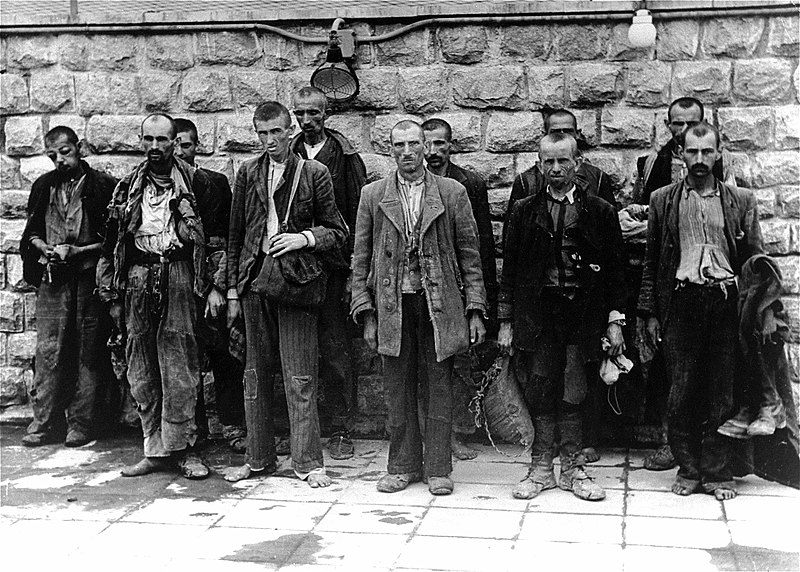 The atrocities the Nazis put the Jewish people and other minorities through in the camps, is well known to be horrible, but many people don’t know the half of it. Hitler had a number of camps in which to imprison these people that he had decided were “undesirable” for one reason or another. Some were even German people, who disagreed with Hitler’s ideas. They became the political prisoners. They were treated no better than their minority counterparts. Disagreeing with Hitler was a fatal choice for the most part.
The atrocities the Nazis put the Jewish people and other minorities through in the camps, is well known to be horrible, but many people don’t know the half of it. Hitler had a number of camps in which to imprison these people that he had decided were “undesirable” for one reason or another. Some were even German people, who disagreed with Hitler’s ideas. They became the political prisoners. They were treated no better than their minority counterparts. Disagreeing with Hitler was a fatal choice for the most part.
Mauthausen was the main political concentration camp in Austria. Mauthausen was not an extermination camp like Auschwitz-Birkenau. Nevertheless, it is estimated that about 100,000 people died at Mauthausen between its inception in 1939 and May 5, 1945, when it became the last camp liberated by the Allies. Sadly, like most of the camps, the liberation came just hours or days too late for some of the prisoners. These unfortunate ones died just prior to the liberation. Their strength gave out, just when rescue was so close.
Mauthausen was a little bit different than the other camps. Probably the greatest difference was the fact that the camp was in close proximity to a rock quarry. Near the quarry was a set of rock stairs known as the Stairs of Death. Most of us couldn’t imagine how a set of stairs could be considered such an instrument of death, that  they would become infamous, but that is exactly what these stairs did, and it is shocking. One of the survivors of Mauthausen gave this account saying, “Inmates were given light clothing and wooden (clogs) and put to work in the stone quarry. This involved carrying heavy stones up 180 steps, known as the “staircase of death” because of the beatings, shootings and fatal accidents to which the crowded mass of inmates was exposed to there. The food was totally inadequate for the heavy labor performed, and a stay in Mauthausen was indeed synonymous with “extermination by work.”
they would become infamous, but that is exactly what these stairs did, and it is shocking. One of the survivors of Mauthausen gave this account saying, “Inmates were given light clothing and wooden (clogs) and put to work in the stone quarry. This involved carrying heavy stones up 180 steps, known as the “staircase of death” because of the beatings, shootings and fatal accidents to which the crowded mass of inmates was exposed to there. The food was totally inadequate for the heavy labor performed, and a stay in Mauthausen was indeed synonymous with “extermination by work.”
Apparently, climbing the stone steps carrying heave stones was not the normal work performed at Mauthausen, but rather a deliberate punishment and death. The unfortunate prisoner or group of prisoners who made the guards angry, found out just how horrific this particular punishment was. One of the most famous incidents involved 47 Allied aviators transported to the camp. These men were essentially murdered in September 1944. Maurice Lampe, a French political prisoner, testified at Nuremberg saying, “For all the prisoners at Mauthausen, the murder of these men has remained in their minds like a scene from Dante’s Inferno. This is how it was done: at the bottom of the steps they loaded stones on the backs of these poor men and they had to carry 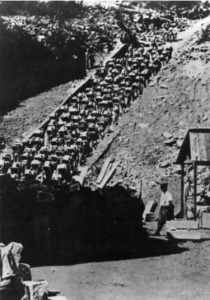 them to the top. The first journey was made with stones weighing 25 to 30 kilos (55 to 65 pounds) and was accompanied by blows. Then they were made to run down. For the second journey, the stones were even heavier; and whenever the poor wretches sank under their burden, they were kicked and hit with a bludgeon. Even stones were hurled at them… In the evening when I returned from the gang with which I was then working, the road which led to the camp was a bath of blood… I almost stepped on the lower jaw of a man. Twenty-one bodies were strewn along the road. Twenty-one had died on the first day. The twenty-six others died the following morning…”
them to the top. The first journey was made with stones weighing 25 to 30 kilos (55 to 65 pounds) and was accompanied by blows. Then they were made to run down. For the second journey, the stones were even heavier; and whenever the poor wretches sank under their burden, they were kicked and hit with a bludgeon. Even stones were hurled at them… In the evening when I returned from the gang with which I was then working, the road which led to the camp was a bath of blood… I almost stepped on the lower jaw of a man. Twenty-one bodies were strewn along the road. Twenty-one had died on the first day. The twenty-six others died the following morning…”
The sight of it was enough to make the description difficult for a man who had seen his share of horrific scenes in his lifetime. Anyone who had been in the camps, or through the camp, or involved in liberating the camps knew first hand the viciousness of the Nazi regime. Once they witnessed these atrocities, they could never forget what they saw. It was a scene that shaped them for the rest of their lives.
 Sometimes an evil leader can come in and before anyone realizes it, the danger that came in with him is real. Unfortunately, not every elected leader is a good one, and when an elected leader, begins to do things like taking away the guns of the people and undermining the police, you find out just how bad they really are. Hitler was that kind of elected leader, and worse. By May of 1934, Hitler had been the chancellor of Germany for 16 months, and the dictator for 14 months. Less than a month after Adolf Hitler was appointed chancellor of Germany, he calls on elements of the Nazi party to act as auxiliary police. The SS (Schutzstaffel), initially Hitler’s bodyguards, and the SA (Sturmabteilung, the German Assault Division), who were the street fighters or Storm Troopers of the Nazi party, now operated as the private army of the Nazi party. SS chief Heinrich Himmler also turned the regular (nonparty) police forces into an instrument of terror. He helped forge the powerful Secret State Police (Geheime Staatspolizei), or Gestapo. These non-uniformed police used ruthless and cruel methods throughout Germany to identify and arrest political opponents and others who refused to obey laws and policies of the Nazi regime. It had taken less than a year to change everything for the people of Germany, who no longer had a say in their own lives.
Sometimes an evil leader can come in and before anyone realizes it, the danger that came in with him is real. Unfortunately, not every elected leader is a good one, and when an elected leader, begins to do things like taking away the guns of the people and undermining the police, you find out just how bad they really are. Hitler was that kind of elected leader, and worse. By May of 1934, Hitler had been the chancellor of Germany for 16 months, and the dictator for 14 months. Less than a month after Adolf Hitler was appointed chancellor of Germany, he calls on elements of the Nazi party to act as auxiliary police. The SS (Schutzstaffel), initially Hitler’s bodyguards, and the SA (Sturmabteilung, the German Assault Division), who were the street fighters or Storm Troopers of the Nazi party, now operated as the private army of the Nazi party. SS chief Heinrich Himmler also turned the regular (nonparty) police forces into an instrument of terror. He helped forge the powerful Secret State Police (Geheime Staatspolizei), or Gestapo. These non-uniformed police used ruthless and cruel methods throughout Germany to identify and arrest political opponents and others who refused to obey laws and policies of the Nazi regime. It had taken less than a year to change everything for the people of Germany, who no longer had a say in their own lives.
While he had control, it was still not enough for the insane chancellor. Hitler, as we all know, would go on to annihilate millions of the Jewish people, as well as anyone else he considered an “undesirable” person. While I’m sure the leaders of the German government considered themselves safe, they would find out just how wrong they were on the Night of the Long Knives…also known as a Blood Purge, or putsch in German. By definition, a blood purge is “the elimination en masse by massacre or execution of individuals considered to constitute an untrustworthy or undesirable element within a party or movement. the elimination en masse by massacre or execution of individuals considered to constitute an untrustworthy or undesirable element within a party.” Hitler had decided that some of his own leaders, his trusted associates, could not be trusted. Maybe he was right, but he didn’t really have proof of his doubts. Nevertheless, He decided that there needed to be a blood purge and the Night of the Long Knives was born.
On June 30, 1934, it began, and continued on until July 2, 1934. During the purge of the Night of the Long Knives (Nacht der langen Messer) Hitler and the Nazi regime used the Schutzstaffel (SS) to deal with the perceived problem of Ernst Röhm and his Sturmabteilung (SA) brownshirts (the original Nazi paramilitary organization). The first thing Hitler did was to take out…or defund the police. Believe it or not, that took out the  last protection of the people. He also took out past opponents of the party, thinking that they might organize against them. It is estimated that at least 85 people were murdered, but many historians think that the death toll was likely in the hundreds. Most of those killed were members of the SA, other victims included close associates of Vice Chancellor Franz von Papen, several Reichswehr (German Army) generals…one of whom, Kurt von Schleicher, was formerly the Chancellor of Germany. Hitler also took out their associates. Gregor Strasser, Hitler’s former competitor for control of the Nazi Party was the next to go. At least one person was killed in a case of mistaken identity, sadly, and several innocent victims were simply killed because they “knew too much.” The Night of the Long Knives…was Hitler’s insane revenge on anyone who dared to oppose him, or even to appear to oppose him.
last protection of the people. He also took out past opponents of the party, thinking that they might organize against them. It is estimated that at least 85 people were murdered, but many historians think that the death toll was likely in the hundreds. Most of those killed were members of the SA, other victims included close associates of Vice Chancellor Franz von Papen, several Reichswehr (German Army) generals…one of whom, Kurt von Schleicher, was formerly the Chancellor of Germany. Hitler also took out their associates. Gregor Strasser, Hitler’s former competitor for control of the Nazi Party was the next to go. At least one person was killed in a case of mistaken identity, sadly, and several innocent victims were simply killed because they “knew too much.” The Night of the Long Knives…was Hitler’s insane revenge on anyone who dared to oppose him, or even to appear to oppose him.
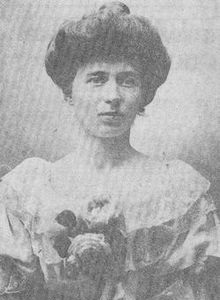 Recently I read a novel that was based on a true story, called “The Alice Network,” by Kate Quinn. Knowing the book was a novel, I assumed that it was entirely fictional, but then I began to wonder, so I researched “The Alice Network” for myself. I found that “The Alice Network” was a very much true story, even if some of the characters in the story were fictional. The head of the Alice Network, Louise Marie Jeanne Henriette de Bettignies, was very much a real person.
Recently I read a novel that was based on a true story, called “The Alice Network,” by Kate Quinn. Knowing the book was a novel, I assumed that it was entirely fictional, but then I began to wonder, so I researched “The Alice Network” for myself. I found that “The Alice Network” was a very much true story, even if some of the characters in the story were fictional. The head of the Alice Network, Louise Marie Jeanne Henriette de Bettignies, was very much a real person.
Louise Marie Jeanne Henriette de Bettignies was born on July 15, 1880 to Henri de Bettignies and Julienne Mabille de Poncheville. She was fluent in French and English, with a good mastery in German and Italian. It made her a perfect candidate for the spy network. Louise became a French secret agent who spied on the Germans for the British during World War I using the pseudonym of Alice Dubois, hence “The Alice Network.” She had under her direction, a number of men and women who mainly worked in the area of Lille, in German occupied France. Her people listened inconspicuously to the talk of the German soldiers when they were not aware, and therefore, not careful to guard their tongues. The gleaned intel was then passed to couriers, of which Louise was one, to be transported by car, train, or on foot to the military leaders they worked for. It was a dangerous occupation, but the spies in the network wanted to serve in the war effort, and this was their chance.
Spies in “The Alice Network” and other such networks, went to work in jobs that were basically normal everyday jobs. They became waitresses, singers, shop workers, all in areas frequented by the enemy. They swallowed their disgust, in order to become almost invisible to the Germans. They never told anyone that they spoke German, because the Germans felt comfortable talking in front of these people who, they thought, couldn’t understand a word they said. It gave the spy networks just the edge they needed. Some spies, like Louise, spent time in makeshift hospitals writing letters in German dictated by dying Germans to their families. Dying men aren’t always careful with the information they give. A wealth of information was passed from these networks to the intelligence officers, and it often proved to be invaluable.
Louise lived with her sister, Germaine at 166 rue d’Isly. From October 4 to 13, 1914, by turning the only cannon that the Lille troops had, the defenders succeeded in deceiving the enemy and holding them for several days under an intense battle that destroyed more than 2,200 buildings and houses, particularly in the area of the station. Louise de Bettignies, aged 28, making full use of the four languages she spoke, including German and English. Through the ruins of Lille, she ensured the supply of ammunition and food to the soldiers who were still firing on the attackers. Then, since she had been a citizen of Lille since 1903, Louise made the decision in October 1914, to engage in resistance and espionage. Due in part to her ability to speak French, English, German, and Italian, she ran a vast intelligence network from her home in the North of France on behalf of the British army and the MI6 intelligence service under the pseudonym Alice Dubois. This network provided important information to the British through occupied Belgium and the Netherlands. The network is estimated to have saved the lives of more than a thousand British soldiers during the 9 months of full operation from January to September 1915.
“The Alice Network” of a hundred people, mostly in forty kilometers of the front to the west and east of Lille, was so effective that she was nicknamed by her English superiors “the queen of spies.” She smuggled men to England, provided valuable information to the Intelligence Service, and prepared for her superiors in London a grid map of the region around Lille. When the German army installed a new battery of artillery, even camouflaged, this position was bombed by the Royal Flying Corps within eight days. Another opportunity allowed her to report the date and time of passage of the imperial train carrying the Kaiser on a secret visit to the front at Lille. During the approach to Lille, two British aircraft bombed the train and emerged, but missed their target. The German command did not understand the unique situation of these forty kilometers of “cursed” front (held by the British) out of nearly seven hundred miles of front. One of her last messages announced the preparation of a massive German attack on Verdun in early 1916. The information was relayed to the French commander who refused to believe it. Incredible!!! After all her success, this worthless French commander refused to believe her. Idiot!!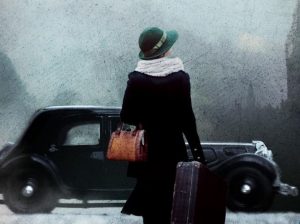
Louise was arrested by the Germans on October 20, 1915 near Tournai. On March 16, 1916, in Brussels, she was sentenced to forced labor for life. After being held for three years, she died on September 27, 1918 as a result of pleural abscesses poorly operated upon at Saint Mary’s Hospital in Cologne. Her body was repatriated on February 21, 1920. On March 16, 1920 a funeral was held in Lille in which she was posthumously awarded the Cross of the Legion of Honor, the Croix de guerre 1914-1918 with palm, and the British Military Medal, and she was made an Officer of the Order of the British Empire. Her body is buried in the cemetery of Saint-Amand-les-Eaux.
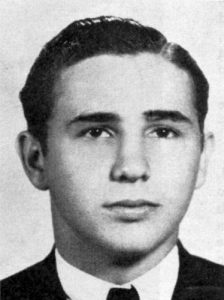 Sometimes, it’s a close call that saves the life of a person, because a difference of inches could have meant the difference between life and death. That was the case for young Corporal Adolf Hitler when he was temporarily blinded on October 14, 1918, by a gas shell that was close enough to temporarily blind him, but unfortunately for the rest of the world, not close enough to kill him. The British shell was part of an attack at Ypres Salient in Belgium, and in the aftermath, Hitler found himself evacuated to a German military hospital at Pasewalk, in Pomerania. Of course, Hitler considered this a great good fortune, with the exception of the temporary blindness. I find myself wishing that the shell had been closer, because the difference of inches could have changed the world, and especially the victims of the Holocaust.
Sometimes, it’s a close call that saves the life of a person, because a difference of inches could have meant the difference between life and death. That was the case for young Corporal Adolf Hitler when he was temporarily blinded on October 14, 1918, by a gas shell that was close enough to temporarily blind him, but unfortunately for the rest of the world, not close enough to kill him. The British shell was part of an attack at Ypres Salient in Belgium, and in the aftermath, Hitler found himself evacuated to a German military hospital at Pasewalk, in Pomerania. Of course, Hitler considered this a great good fortune, with the exception of the temporary blindness. I find myself wishing that the shell had been closer, because the difference of inches could have changed the world, and especially the victims of the Holocaust.
Like many young men of the period, Hitler was drafted for Austrian military service, but when he reported, he was turned down due to lack of fitness. In the summer of 1914, Hitler had moved to Munich. When World War I began, he asked for and received special permission to enlist as a German soldier. It all seemed like a noble thing to do. Hitler was a member of the 16th Bavarian Reserve Infantry Regiment. He traveled to France in October 1914. There, he saw heavy action during the First Battle of Ypres, earning the Iron Cross that December for dragging a wounded comrade to safety. These things rather surprise me, give Hitler’s reputation for thinking only of himself.
Over the course of the next two years, Hitler took part in some of the fiercest struggles of the war, including 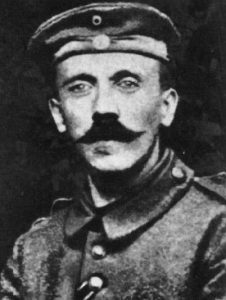 the Battle of Neuve Chapelle, the Second Battle of Ypres and the Battle of the Somme. He was wounded in the leg by a shell blast on October 7, 1916, near Bapaume, France. Following his hospital stay. Hitler was sent to recover near Berlin, after which he returned to his old unit by February 1917. According to Hans Mend, a comrade of Hitler, he was given to rants on the dismal state of morale and dedication to the cause on the home front in Germany. According to Mend, “He sat in the corner of our mess holding his head between his hands in deep contemplation. Suddenly he would leap up, and running about excitedly, say that in spite of our big guns victory would be denied us, for the invisible foes of the German people were a greater danger than the biggest cannon of the enemy.” It would seem that Hitler’s crazed mind was beginning to present itself. As I look at a picture of Hitler as a young man, I wonder what happened to him that changed him so much. Yung Hitler didn’t look like the crazed, evil dictator the world knew
the Battle of Neuve Chapelle, the Second Battle of Ypres and the Battle of the Somme. He was wounded in the leg by a shell blast on October 7, 1916, near Bapaume, France. Following his hospital stay. Hitler was sent to recover near Berlin, after which he returned to his old unit by February 1917. According to Hans Mend, a comrade of Hitler, he was given to rants on the dismal state of morale and dedication to the cause on the home front in Germany. According to Mend, “He sat in the corner of our mess holding his head between his hands in deep contemplation. Suddenly he would leap up, and running about excitedly, say that in spite of our big guns victory would be denied us, for the invisible foes of the German people were a greater danger than the biggest cannon of the enemy.” It would seem that Hitler’s crazed mind was beginning to present itself. As I look at a picture of Hitler as a young man, I wonder what happened to him that changed him so much. Yung Hitler didn’t look like the crazed, evil dictator the world knew
Hitler continued to earn citations for bravery over the next year, including an Iron Cross 1st Class for “personal bravery and general merit” in August 1918 for single-handedly capturing a group of French soldiers hiding in a shell hole during the final German offensive on the Western Front. Then, on October 14, 1918, Hitler received the injury that put an end to his service in World War I. He learned of the German surrender while recovering at Pasewalk. Hitler was furious and frustrated by the news. He said, “I staggered and stumbled back to my  ward and buried my aching head between the blankets and pillow.” Hitler felt he and his fellow soldiers had been betrayed by the German people. I’m amazed that he did not put them in the camps too. In 1941, Hitler as Führer would reveal the degree to which his career and its terrible legacy had been shaped by the World War I, writing that “I brought back home with me my experiences at the front; out of them I built my National Socialist community.”
ward and buried my aching head between the blankets and pillow.” Hitler felt he and his fellow soldiers had been betrayed by the German people. I’m amazed that he did not put them in the camps too. In 1941, Hitler as Führer would reveal the degree to which his career and its terrible legacy had been shaped by the World War I, writing that “I brought back home with me my experiences at the front; out of them I built my National Socialist community.”
When I think of what might have been, but for a difference of inches, I find it very ironic. If that shell had hit just a few inches closer, perhaps Hitler would have died a hero in his nation, before he could become the epitome of evil…to the world, and to many of his own people. I suppose World War I and II, as well as the other wars, would have still happened, but maybe, quite likely, the Holocaust would not have happened. Just a few inches. If only.
 Born Jewish, on April 4, 1922, in Berlin, Germany, did not necessarily set Marie Jalowicz up for a long carefree life. Marie was 11 years old when the Nazi Party came to power, and soon after began to imprison her family members. By age 20, Marie was forced to fend for herself. She found herself faced with the difficult task of constantly avoiding the Nazis. For Marie, this meant somehow assimilating into German life…basically pretending to be a non-Jew. I can’t imagine having to pretend to be a nationality other than my own, but that is what she had to do. Anything about her that was Jewish had to be set aside, forgotten, or hidden from the eyes and ears of the Nazis, who seemed to be everywhere around her.
Born Jewish, on April 4, 1922, in Berlin, Germany, did not necessarily set Marie Jalowicz up for a long carefree life. Marie was 11 years old when the Nazi Party came to power, and soon after began to imprison her family members. By age 20, Marie was forced to fend for herself. She found herself faced with the difficult task of constantly avoiding the Nazis. For Marie, this meant somehow assimilating into German life…basically pretending to be a non-Jew. I can’t imagine having to pretend to be a nationality other than my own, but that is what she had to do. Anything about her that was Jewish had to be set aside, forgotten, or hidden from the eyes and ears of the Nazis, who seemed to be everywhere around her.
Marie knew that as the situation for Jews in Nazi Germany deteriorated, things would grow steadily worse for her. She had to somehow come up with a way to virtually hide in plain sight. When a postman wrongly delivered a letter for a job offer intended for the neighbor in 1941, she told a postman that her “neighbor” Marie was taken by the Nazis, then she simply started walking around without a star on her jacket. She was successfully living under a false identity. She took the job and began  working at the Siemens arms factory in her neighbor’s place. While living this double life, Jalowicz sabotaged production at the arms factory where she worked. Marie evaded Nazi capture through a long string of forgeries, impersonations, and help from people from every walk of life. Marie became Johanna Koch, using her wit and charm to seduce people in positions that could help her and moved around constantly. She took the words of a friend of hers to heart, “In absurd times, everything is absurd. You can save yourselves only by absurd means since the Nazis are out to murder us all.” On more than one occasion she tried to flee Germany, narrowly evading apprehension and escaping back to her homeland each time. She relocated often, and at one point was sold to an abusive Nazi with late-stage syphilis for 15 marks, which added to her cover as a non-Jew. In the coming years, she took menial jobs and lived in several Berlin flats, at times with roommates who were fervent Nazis. I can’t imagine how awful it was for her.
working at the Siemens arms factory in her neighbor’s place. While living this double life, Jalowicz sabotaged production at the arms factory where she worked. Marie evaded Nazi capture through a long string of forgeries, impersonations, and help from people from every walk of life. Marie became Johanna Koch, using her wit and charm to seduce people in positions that could help her and moved around constantly. She took the words of a friend of hers to heart, “In absurd times, everything is absurd. You can save yourselves only by absurd means since the Nazis are out to murder us all.” On more than one occasion she tried to flee Germany, narrowly evading apprehension and escaping back to her homeland each time. She relocated often, and at one point was sold to an abusive Nazi with late-stage syphilis for 15 marks, which added to her cover as a non-Jew. In the coming years, she took menial jobs and lived in several Berlin flats, at times with roommates who were fervent Nazis. I can’t imagine how awful it was for her.
Marie went on to become a German philologist and historian of philosophy, pursued a career in academia, 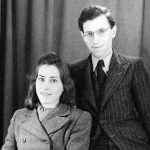 and received a Ph.D. in ancient literature and art history at Berlin’s Humboldt University. Then, after the war, she become a professor at Humboldt University, where she worked until her death in 1998. Just before her death she recorded 77 cassette tapes of audio with her son, Hermann. In the tapes, for the first time, Marie chronicled her experience during the Nazi reign. They were later compiled into a book called, Underground in Berlin: A Young Woman’s Extraordinary Tale of Survival in the Heart of Nazi Germany. She became known to larger audiences for this, her autobiographical account of the persecution of Jews in Nazi Germany, which was published posthumously. Marie died on September 16, 1998. She returned to her original identity only on her deathbed. Her mother died of cancer in 1938. Her father died in 1941. She is survived by her only son, Hermann Simon.
and received a Ph.D. in ancient literature and art history at Berlin’s Humboldt University. Then, after the war, she become a professor at Humboldt University, where she worked until her death in 1998. Just before her death she recorded 77 cassette tapes of audio with her son, Hermann. In the tapes, for the first time, Marie chronicled her experience during the Nazi reign. They were later compiled into a book called, Underground in Berlin: A Young Woman’s Extraordinary Tale of Survival in the Heart of Nazi Germany. She became known to larger audiences for this, her autobiographical account of the persecution of Jews in Nazi Germany, which was published posthumously. Marie died on September 16, 1998. She returned to her original identity only on her deathbed. Her mother died of cancer in 1938. Her father died in 1941. She is survived by her only son, Hermann Simon.
 When we think of heroes during the Nazi years, we think mostly of men, but there were a few women who were real heroes too. One such woman, Sophia Magdalena Scholl, who was born on May 9, 1921, was a German student, who was also a serious anti-Nazi political activist. She was active within the White Rose non-violent resistance group in Nazi Germany. Scholl was the fourth of six children born to Magdalena (Müller) and liberal politician and ardent Nazi critic Robert Scholl. Her father was the mayor of her hometown of Forchtenberg am Kocher in the Free People’s State of Württemberg, at the time of her birth.
When we think of heroes during the Nazi years, we think mostly of men, but there were a few women who were real heroes too. One such woman, Sophia Magdalena Scholl, who was born on May 9, 1921, was a German student, who was also a serious anti-Nazi political activist. She was active within the White Rose non-violent resistance group in Nazi Germany. Scholl was the fourth of six children born to Magdalena (Müller) and liberal politician and ardent Nazi critic Robert Scholl. Her father was the mayor of her hometown of Forchtenberg am Kocher in the Free People’s State of Württemberg, at the time of her birth.
Scholl was brought up in the Lutheran church. She entered junior or grade school at the age of seven, and was considered an intelligent child who learned easily. Her childhood was a happy and carefree one. In 1930, the family moved to Ludwigsburg and then two years later to Ulm where her father had a business consulting office. These were definitely the best years of her life.
In 1932, after Scholl started attending a secondary school for girls, at the age of twelve, she chose to join the Bund Deutscher Mädel (League of German Girls), as did most of her classmates. It was as common as joining the girl scouts was in the United States. Her initial enthusiasm gradually gave way to criticism. She was aware of the dissenting political views of her father, friends, and some teachers. Even her own brother Hans, who once eagerly participated in the Hitler Youth program, became entirely disillusioned with the Nazi Party. Sophia was quickly learning of the horrors of Hitler and his Nazi regime. Political attitude had become an essential criterion in her choice of friends. The arrest of her brothers and friends in 1937 for participating in the German Youth Movement left a strong impression on her.
In 1943, with the Nazi movement in full swing, Sophia and her brother, Hans were at the University of Munich distributing anti-war leaflets when they were arrested and charged with high treason. Of course, handing out  anti-war leaflets in the United States would never be considered cause for a high treason conviction, but then Sophia and her brother did not live in the United States. In the People’s Court before Judge Roland Freisler on 22 February 1943, Scholl was recorded as saying these words, “Somebody, after all, had to make a start. What we wrote and said is also believed by many others. They just don’t dare express themselves as we did.” There was no testimony allowed for the defendants; this was their only defense. The brother and sister were subsequently convicted of the high treason charges, and as a result, were executed by guillotine on February 22, 1943. Since the 1970s, Scholl has been extensively commemorated for her anti-Nazi resistance work.
anti-war leaflets in the United States would never be considered cause for a high treason conviction, but then Sophia and her brother did not live in the United States. In the People’s Court before Judge Roland Freisler on 22 February 1943, Scholl was recorded as saying these words, “Somebody, after all, had to make a start. What we wrote and said is also believed by many others. They just don’t dare express themselves as we did.” There was no testimony allowed for the defendants; this was their only defense. The brother and sister were subsequently convicted of the high treason charges, and as a result, were executed by guillotine on February 22, 1943. Since the 1970s, Scholl has been extensively commemorated for her anti-Nazi resistance work.
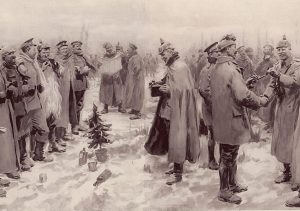 It was 1914, and World War I was in the 5th month of a 51 month offensive. The war effort was in a bit of a transition period, following the stalemate of the Race to the Sea and the indecisive result of the First Battle of Ypres. As leadership on both sides reconsidered their strategies, hostilities entered a bit of a lull. The men were hoping for a break in the action for Christmas that year, but they had to wait for their orders. When the orders came down, it was not to be a Christmas truce, but rather a Christmas strike. As the first men to go forth prepared to make the first advances, some men were killed, and some returned. It was the way of war. The leadership wanted to take advantage of the possibility that the enemy might not expect a Christmas attack. One of the younger men…17 years old to be exact, couldn’t help himself. He began to sing Silent Night.His superiors ordered it to be quiet. They feared that the enemy was waiting in the darkness.
It was 1914, and World War I was in the 5th month of a 51 month offensive. The war effort was in a bit of a transition period, following the stalemate of the Race to the Sea and the indecisive result of the First Battle of Ypres. As leadership on both sides reconsidered their strategies, hostilities entered a bit of a lull. The men were hoping for a break in the action for Christmas that year, but they had to wait for their orders. When the orders came down, it was not to be a Christmas truce, but rather a Christmas strike. As the first men to go forth prepared to make the first advances, some men were killed, and some returned. It was the way of war. The leadership wanted to take advantage of the possibility that the enemy might not expect a Christmas attack. One of the younger men…17 years old to be exact, couldn’t help himself. He began to sing Silent Night.His superiors ordered it to be quiet. They feared that the enemy was waiting in the darkness.
Then, a miracle occurred. In the week leading up to the 25th of December, French, German, and British soldiers crossed trenches to exchange seasonal greetings…and to talk. In some areas, men from both sides ventured into what was called no man’s land, because to go there was to risk death. Nevertheless, on that Christmas Eve and Christmas Day, things seemed different. The soldiers took a chance and stepped forward, hoping to convince their enemies that they only wanted to bury their dead, and hoping that it would be 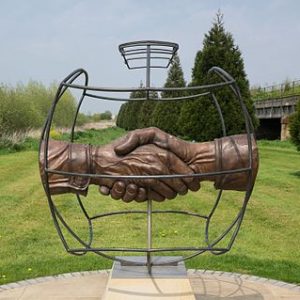 agreeable to stop the fighting for one hour to bury the dead. As they buried their dead, with heavy hearts, someone suggested that they take Christmas Day off. This was totally against their orders, and they knew that at some point they were going to have to go back and follow their orders. They were going to have to become enemies again. Still, for now…for this day, they mingled and exchange food and souvenirs. There were joint burial ceremonies and prisoner swaps. Men played games of football with one another, giving one of the most memorable images of the truce. Peaceful behavior was not ubiquitous, however, and fighting continued in some sectors, while in others the sides settled on little more than arrangements to recover bodies. Several meetings ended in carol-singing. Someone commented, “How many times in a life do you actually meet your enemy face to face.” It was almost strange to them, because these “enemies” were not the monsters they expected them to be. These were simply men, just like they were. I’m sure the men were in shock. it’s hard to have your total view of your enemy change so drastically and then have to follow your orders, pickup your weapons, and shoot at the same men again. The Christmas truce (German: Weihnachtsfrieden; French: Trêve de Noël) was a series of widespread but unofficial ceasefires along the Western Front of World War I around Christmas 1914.
agreeable to stop the fighting for one hour to bury the dead. As they buried their dead, with heavy hearts, someone suggested that they take Christmas Day off. This was totally against their orders, and they knew that at some point they were going to have to go back and follow their orders. They were going to have to become enemies again. Still, for now…for this day, they mingled and exchange food and souvenirs. There were joint burial ceremonies and prisoner swaps. Men played games of football with one another, giving one of the most memorable images of the truce. Peaceful behavior was not ubiquitous, however, and fighting continued in some sectors, while in others the sides settled on little more than arrangements to recover bodies. Several meetings ended in carol-singing. Someone commented, “How many times in a life do you actually meet your enemy face to face.” It was almost strange to them, because these “enemies” were not the monsters they expected them to be. These were simply men, just like they were. I’m sure the men were in shock. it’s hard to have your total view of your enemy change so drastically and then have to follow your orders, pickup your weapons, and shoot at the same men again. The Christmas truce (German: Weihnachtsfrieden; French: Trêve de Noël) was a series of widespread but unofficial ceasefires along the Western Front of World War I around Christmas 1914.
The Christmas Truces of 1914, while wonderful for the men, were not to be a Christmas tradition in World War I. The following year, a few units arranged ceasefires but the truces were not nearly as widespread as in 1914.  This was, in part, due to strongly worded orders from the high commands of both sides prohibiting truces. It was evident that while the mini-mutiny of 1914 was tolerated and the men were not punished, that this would not be tolerated in the future. It really didn’t matter, because the Soldiers were no longer amenable to truce by 1916. The war had become increasingly bitter after devastating human losses suffered during the battles of the Somme and Verdun, and the use of poison gas. While a Christmas truce would be nice in theory, bitter and angry feelings on both sides of a war make it an impractical idea. Still, in 1914, the miracle of the Christmas Truce was a wonderful treat for the men on all sides of a bitter war.
This was, in part, due to strongly worded orders from the high commands of both sides prohibiting truces. It was evident that while the mini-mutiny of 1914 was tolerated and the men were not punished, that this would not be tolerated in the future. It really didn’t matter, because the Soldiers were no longer amenable to truce by 1916. The war had become increasingly bitter after devastating human losses suffered during the battles of the Somme and Verdun, and the use of poison gas. While a Christmas truce would be nice in theory, bitter and angry feelings on both sides of a war make it an impractical idea. Still, in 1914, the miracle of the Christmas Truce was a wonderful treat for the men on all sides of a bitter war.
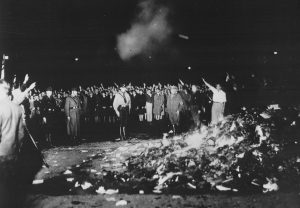 Book burning is the ritual destruction by fire of books or other written materials. This practice is usually carried out in a public place, so as to further destroy any sense of control of one’s own life. The burning of books represents an element of censorship and usually proceeds from a cultural, religious, or political opposition to the materials in question. Sometimes those burning the books think they are “protecting” the people from something they deem to be evil, but more often, the books simply don’t agree with the agenda of the controlling group. Such was the case with the most famous book burning, which took place under the Nazi regime on May 10, 1933. The May 1933 book burning in Nazi Germany was preceded in nineteenth century Germany. In 1817, German student associations (Burschenschaften) chose the 300th anniversary of Luther’s 95 Theses to hold a festival at the Wartburg, a castle in Thuringia where Luther had sought sanctuary after his excommunication. The students were demonstrating for a unified country. Germany was then a patchwork of states. During the protest, the students burned anti-national and reactionary texts and literature which the students viewed as “Un-German” in nature or content. I wonder if they had any idea that the freedom to protest was the very thing they were looking to take away in the future Germany.
Book burning is the ritual destruction by fire of books or other written materials. This practice is usually carried out in a public place, so as to further destroy any sense of control of one’s own life. The burning of books represents an element of censorship and usually proceeds from a cultural, religious, or political opposition to the materials in question. Sometimes those burning the books think they are “protecting” the people from something they deem to be evil, but more often, the books simply don’t agree with the agenda of the controlling group. Such was the case with the most famous book burning, which took place under the Nazi regime on May 10, 1933. The May 1933 book burning in Nazi Germany was preceded in nineteenth century Germany. In 1817, German student associations (Burschenschaften) chose the 300th anniversary of Luther’s 95 Theses to hold a festival at the Wartburg, a castle in Thuringia where Luther had sought sanctuary after his excommunication. The students were demonstrating for a unified country. Germany was then a patchwork of states. During the protest, the students burned anti-national and reactionary texts and literature which the students viewed as “Un-German” in nature or content. I wonder if they had any idea that the freedom to protest was the very thing they were looking to take away in the future Germany.
Then, in 1933, Nazi German authorities, decided to synchronize professional and cultural organizations with Nazi ideology and policy (Gleichschaltung). Nazi Minister for Popular Enlightenment and Propaganda, Joseph Goebbels, spearheaded an effort to bring German arts and culture in line with Nazi goals. The government began to remove cultural organizations of Jewish and other officials who were alleged to be politically suspect or who performed or created art works which Nazi ideologues labeled “degenerate.” Goebbels also had a strong ally in the National Socialist German Students’ Association (Nationalsozialistischer Deutscher Studentenbund), so he used them to bring the literary phase into being. German university students were at the forefront of the early Nazi movement, and in the late 1920s. Many of them filled the ranks of various Nazi formations. The ultra-nationalism and antisemitism of middle-class, secular student organizations had been intense and vocal for decades. After World War I, many students opposed the Weimar Republic (1919–1933) and found in National Socialism a suitable vehicle for their political discontent and hostility.
On April 6, 1933, the Nazi German Student Association’s Main Office for Press and Propaganda proclaimed a nationwide “Action against the Un-German Spirit,” to end in a literary purge or “cleansing” (Säuberung) by fire. Local chapters were to supply the press with releases and commissioned articles, offer blacklists of “un-German” authors, sponsor well-known Nazi figures to speak at public gatherings, and negotiate for radio broadcast time. Then, in a symbolic act of ominous significance, on May 10, 1933, university students burned upwards of 25,000 volumes of “un-German” books, presaging an era of state censorship and control of culture. On the evening of May 10, in most university towns, right-wing students marched in torchlight parades “against the un-German spirit.” The scripted rituals called for high Nazi officials, professors, university rectors, and university student leaders to address the participants and spectators. In Berlin, some 40,000 persons gathered  in the Opernplatz to hear Joseph Goebbels delivered a fiery address: “No to decadence and moral corruption!” He went on to say, “Yes to decency and morality in family and state! I consign to the flames the writings of Heinrich Mann, Ernst Gläser, Erich Kästner.” Among the authors whose books student leaders burned that night were well-known socialists such as Bertolt Brecht and August Bebel; the founder of the concept of communism, Karl Marx; critical “bourgeois” writers like the Austrian playwright Arthur Schnitzler; and “corrupting foreign influences,” among them American author Ernest Hemingway. I don’t agree with some of these writings, but I also don’t agree with their destruction. People can make up their own minds.
in the Opernplatz to hear Joseph Goebbels delivered a fiery address: “No to decadence and moral corruption!” He went on to say, “Yes to decency and morality in family and state! I consign to the flames the writings of Heinrich Mann, Ernst Gläser, Erich Kästner.” Among the authors whose books student leaders burned that night were well-known socialists such as Bertolt Brecht and August Bebel; the founder of the concept of communism, Karl Marx; critical “bourgeois” writers like the Austrian playwright Arthur Schnitzler; and “corrupting foreign influences,” among them American author Ernest Hemingway. I don’t agree with some of these writings, but I also don’t agree with their destruction. People can make up their own minds.
 During the gold rush years, in 1857, to be exact, two German men who had been traveling with a wagon train headed to California, decided to leave the rest of the group and headed out on their own. They wound up in the Mono Lake region of northern California. One of the men would later describe the area as “the burnt country.” While crossing the Sierra Nevada near the headwaters of the Owens River, they sat down to rest near a stream. Looking around, they noticed a curious looking rock ledge of red lava filled with what appeared to be pure lumps of gold “cemented” together. That was how their “mine” got its name.
During the gold rush years, in 1857, to be exact, two German men who had been traveling with a wagon train headed to California, decided to leave the rest of the group and headed out on their own. They wound up in the Mono Lake region of northern California. One of the men would later describe the area as “the burnt country.” While crossing the Sierra Nevada near the headwaters of the Owens River, they sat down to rest near a stream. Looking around, they noticed a curious looking rock ledge of red lava filled with what appeared to be pure lumps of gold “cemented” together. That was how their “mine” got its name.
The ledge of that hillside was literally loaded with the ore. The excited men couldn’t believe their eyes. One of the men was laughing at the other as he pounded away about ten pounds of the ore to take with him…because he did not believe it was really gold. The man who believe that it was gold drew a map to the location and the two men continued their journey. Along the way, the disbeliever died and since he was laden with so much ore, the believer tossed the majority of the samples. Then, after crossing the mountains, he followed the San Joaquin River to the mining camp of Millerton, California. After a long, weary journey, the German had become ill and soon went to San Francisco for treatment. He was diagnosed and cared for by a Doctor Randall who told the man he was terminally ill with consumption (tuberculosis). With no money to pay the doctor and too ill to return to the treasure, he paid his caretaker with the ore, the map he had drawn, and provided him with a detailed description.
Doctor Randall shared this knowledge with a few of his friends and together they decided to go for the gold. They arrived at old Monoville in the spring of 1861. After enlisting additional men to help, Randall’s group began to prospect on a quarter-section of land called Pumice Flat. Their claim is thought to have been some eight miles north of Mammoth Canyon…the 120 acres were near what became known as Whiteman’s Camp. Word of possibly a huge cache of gold spread quickly and before long miners flooded the area hunting for the gold laden red “cement.” One story tells that two of Doctor Randall’s party had in fact found the “Cement Mine,” taking several thousand dollars from the ledge. Unfortunately, for those two men, the area was filled with the Owens Valley Indian War which began in 1861. The Paiute Indians, who had heretofore been generally peaceful, were angered at the large numbers of prospectors who had invaded their lands. The two miners who  had allegedly found the lost ledge were killed by the Indians before they were able to tell of its location.
had allegedly found the lost ledge were killed by the Indians before they were able to tell of its location.
Though the “cement” outcropping was never found again, the many prospectors who flooded the eastern Sierra region did find gold. Apparently there was a huge cache there after all. This resulted in the mining camps of Dogtown, Mammoth City, Lundy Canyon, Bodie, and many others. The lost lode is said to lie somewhere in the dense woods near the Sierra Mountain headwaters of the San Joaquin River’s middle fork. If it really exists, it must be very well hidden.
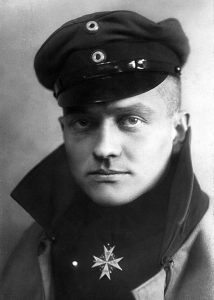 Who fired the shot that killed Richthofen? And who was Richthofen anyway? First, Richthofen was also known as the Red Baron. Manfred Albrecht Freiherr von Richthofen was born on May 2, 1892. He was a fighter pilot with the German Air Force during World War I, and is considered the ace-of-aces of the war. He was officially credited with 80 air combat victories.
Who fired the shot that killed Richthofen? And who was Richthofen anyway? First, Richthofen was also known as the Red Baron. Manfred Albrecht Freiherr von Richthofen was born on May 2, 1892. He was a fighter pilot with the German Air Force during World War I, and is considered the ace-of-aces of the war. He was officially credited with 80 air combat victories.
Nevertheless, as it goes with fighter pilots, their lives are always in jeopardy, and not all of them will come out of war alive. Such was the case with the Red Baron. The end came for him on April 21, 1918. It’s possible that he made mistakes on that final flight. Richthofen was a highly experienced and skilled fighter pilot, who was fully aware of the risk from ground fire. Furthermore, he concurred with the rules of air fighting created by his late mentor Boelcke, who specifically advised pilots not to take unnecessary risks. With that in mind, one must wonder if Richthofen’s judgement during his last combat was unsound or somehow compromised.
Several theories have been proposed to account for his behavior. In 1999, a German medical researcher, Henning Allmers, published an article in the British medical journal The Lancet, suggesting it was likely that brain damage from the head wound Richthofen suffered in July 1917, played a part in the Red Baron’s death. This was supported by a 2004 paper by researchers at the University of Texas. Richthofen’s behavior after his injury was noted as consistent with brain-injured patients, and such an injury could account for his perceived lack of judgement on his final flight…a flight in which he was flying too low over enemy territory and suffering target fixation, which is an attentional phenomenon observed in humans in which an individual becomes so focused on an observed object, that they inadvertently increase their risk of colliding with the object.
Still, the biggest question is not why the Red Baron made the mistake that would get him killed, but rather who killed him. The RAF credited Arthur Roy Brown, an RNAS lieutenant with shooting down the Red Baron, but it is 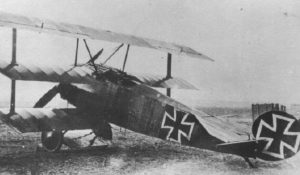 now generally agreed that the bullet that hit the Red Baron was fired from the ground. The Red Baron died following an extremely serious and inevitably fatal chest wound from a single bullet, penetrating from the right armpit and resurfacing from his left chest. Brown’s attack was from behind and above, and from Red Baron’s left. Even more conclusively, Red Baron could not have continued his pursuit for as long as he did…up to two minutes…had this wound come from Brown’s guns. Brown himself never spoke much about what happened that day, claiming, “There is no point in me commenting, as the evidence is already out there.”
now generally agreed that the bullet that hit the Red Baron was fired from the ground. The Red Baron died following an extremely serious and inevitably fatal chest wound from a single bullet, penetrating from the right armpit and resurfacing from his left chest. Brown’s attack was from behind and above, and from Red Baron’s left. Even more conclusively, Red Baron could not have continued his pursuit for as long as he did…up to two minutes…had this wound come from Brown’s guns. Brown himself never spoke much about what happened that day, claiming, “There is no point in me commenting, as the evidence is already out there.”
Many sources, including a 1998 article by Geoffrey Miller, a physician and historian of military medicine, and a 2002 British Channel 4 documentary, have suggested that Sergeant Cedric Popkin was the person most likely to have killed Richthofen. Popkin was an anti-aircraft (AA) machine gunner with the Australian 24th Machine Gun Company, and was using a Vickers gun. He fired at Richthofen’s aircraft on two occasions…first as the Baron was heading straight at his position, and then at long range from the right. Given the nature of Richthofen’s wounds, Popkin was in a position to fire the fatal shot, when the pilot passed him for a second time, on the right. Some confusion has been caused by a letter that Popkin wrote, in 1935, to an Australian official historian. It stated Popkin’s belief that he had fired the fatal shot as Red Baron flew straight at his position. In the latter respect, Popkin was incorrect. The bullet that caused the Baron’s death came from the side.
A 2002 Discovery Channel documentary suggests that Gunner W. J. “Snowy” Evans, a Lewis machine gunner with the 53rd Battery, 14th Field Artillery Brigade, Royal Australian Artillery is likely to have killed Red Baron. 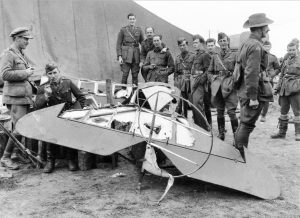 Miller and the Channel 4 documentary dismiss this theory, because of the angle from which Evans fired at Richthofen.
Miller and the Channel 4 documentary dismiss this theory, because of the angle from which Evans fired at Richthofen.
Other sources have suggested that Gunner Robert Buie, also of the 53rd Battery, may have fired the fatal shot. There is little support for this theory. In 2007, a municipality in Sydney recognized Buie as the man who shot down Richthofen, placing a plaque near Buie’s former home. Buie, who died in 1964, has never been officially recognized in any other way. I suppose that, in reality, we will never really know for sure who killed Red Baron, but the theories present an interesting puzzle, and one that will most likely never be solved.

